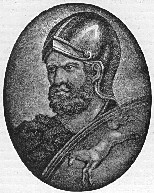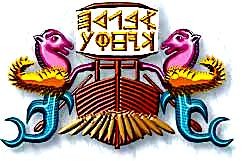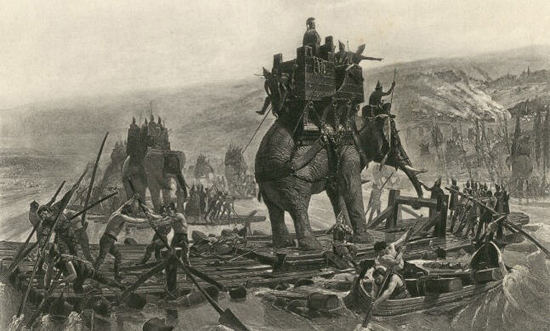|
Archaeologists
tracing the history of the early humans believe that it
was the desert nomads of Western Asia and the Arab lands
who were among the first to occupy Syria, where they
founded the great and noble City of Damascus. Among them
were a few nomads who believed that Damascus offered
little scope for their progress and crossed into the
Lebanon Mountains, settling themselves in the narrow
strip of land that was North of Palestine. They occupied
a strip of land that was about a hundred and twenty
miles long and more or less twenty miles wide between
the present day Lebanon and the Mediterranean Sea. The
people who lived around Damascus came to be known as
Aramaeans and those who occupied the narrow strip of
land near Lebanon were called Phoenicians. They soon
found that the new land, on which they settled, was not
right for a flourishing agriculture by the methods known
at that time, and were forced to take to trade to
survive as a civilization – the Aramaeans by land and
the Phoenicians by sea.
The opportunities of
establishing trade by land were limited to the Aramaeans.
However, the sea offered unlimited opportunities to the
Phoenicians. The Aramaeans traveling through land along
the trade routes, as carriers of commerce, are credited
with popularizing the use of the alphabet to people to
the Near East – the Aramaic dialect that later developed
as a common language of the countries of the Levant –
the language that was spoken also by Jesus Christ.
Nevertheless, they made little impact on the life of the
people with whom they came into contact, but not as much
as the Phoenicians. Ancient historians refer to them as
Canaanites. The Greeks called them “Phoinikes,” which
means “red people.” The Phoenicians who had taught the
alphabet to the Aramaeans had simplified the old
hieroglyphics of the Nile Valley Civilization and the
Cuneiform writing known to the people of Mesopotamia and
developed a language, which they could both read and
write and make it popular among the ancient people of
the larger part of the Middle East.
After having
discovered early that their new home was not right for
agriculture because of its mountainous terrain, the
Phoenicians decided to take to the sea. However, the
waters around them were not calm and peaceful, and they
had to set sail on their crude boats in their early
experimental voyages into the open sea. The stormy
waters of the sea led them to discover by a trial and
error method how to innovate on their existing boats,
and over a period of time they became expert sailors of
the ancient times. The Cedar wood that grew in plenty on
the Mountains of Lebanon provided the ancient
Phoenicians with the right type of wood to make sturdy
sailing vessels, and its abundance in that region made
it an article for export to distant lands across the
sea.

From the early
times, the ancient Egyptians prized Cedar wood as a
building material for their houses and temples had
established trading posts in Phoenicia for hauling the
logs of wood to Egypt in their sailing vessels before
the nomads occupied and settled down in the region and
started monopolizing its trade. Another important factor
that contributed to the growth and riches of the
Phoenician Civilization was the abundance of shellfish
available along the coast of Lebanon, from which they
managed to extract a crimson dye - used for dyeing
cloths - that was in great demand in the countries of
the East. With the availability of the two prized
articles of trade in their possession, the Phoenicians
set out to trade in a large scale and by 1700 BCE they
had become leading commercial traders, sailing to
faraway lands and navigating their ships by the North
Star. The Phoenician enjoyed that status until the
arrival of Alexander the Great in the fourth century
BCE.
The Phoenicians
established strong trading cities along the coast of
Lebanon, each with a government on its own that joined
hands with other cities during a crisis. They did not
believe in forming a Central Government or a Kingdom to
watch over the administration of these cities and they
were pretty much left to their own devices governing by
themselves without a Central Authority. The riches of
the Phoenicians led Egypt to conquer their cities by
1500 BCE, and later followed by the Assyrians, the
Chaldeans, the Persians and finally the Romans. However,
the foreigners soon found out that it was in their
interests to allow the Phoenicians the freedom of trade
and they continued to thrive as a trading community in
spite of foreign domination of their lands.
The Phoenicians
were energetic and adventurous commercial traders, a
quality that could not be matched by the occupying
powers of the Phoenician cities. They had established
ports in the cities of Tyre, Sidon and Byblos and were
sailing to different parts of the world where trade was
profitable. They managed to set up trading posts and
colonies in those cities - the trading centers of the
world - to which came articles of commerce from distant
lands, and from here they shipped out raw material and
finished goods. They dominated trade in Cyprus, Crete
and other islands of the Aegean Sea, as well as the
Black Sea ports, Sardinia, Marseilles, Cornwall, and
Carthage. They maintained garrisons in Malta, Sicily and
Corsica. From Spain they secured silver, lead and zinc,
and from Cornwall they acquired the highly valuable
alloy tin. From Africa they obtained gold and ostrich
feathers. India offered to them ivory, spices and cotton
goods. The Land of Arabia supplied them with incense,
costly spices and perfumes. Syria sold them the sweetest
wines made in the world. Greece presented them with a
profitable trade of precious goblets that were made up
from metal and decorated glass. In these the Phoenicians
acted as middlemen offering to every country something
that the other did not have, and profited immensely in
their business enterprises.
Once they had
become masters of trade, the Phoenicians set up
manufacturing units in their cities from the knowledge
acquired from foreign shores and they were soon turning
out exquisite carpets and beautiful crimson cloths.
Their artisans became experts in decorating bronze,
silver and glassware articles that commanded a wide
market all over the trading world. Naturally, the
demand for their articles in the world markets made them
rich and prosperous and the cities of Phoenicia were
busy centers of trade and their ports hummed with
activity round the clock. The modern day archeologists
who unearthed the Tell-al-Amarna tablets of Egypt tell
us that in the fifteenth century BCE, the Port of Tyre
was famous for its commerce, and continued to flourish
in the days of King Solomon the Wise. Later, political
conditions forced the Phoenicians to abandon the ports
of Tyre and Sidon, after a 13-year old siege by the
Babylonians. The Phoenicians then turned the city of
Carthage, near Tunisia, to their main center of
activities, and during the sixth century BCE it boasted
a population of 750,000 with their own culture known as
“Punic” to the Romans.

The riches of
Carthage and the powerful impregnable defenses built-in
the city made it a formidable power in the Mediterranean
Sea. The Romans who were dreaming of extending their
supremacy over the Mediterranean Sea soon arrived at the
conclusion that they could only become the masters of
the region after crushing the might of the Phoenician
empire based in this city. And they could realize their
dreams only after a century of hard fighting with the
Phoenicians – in the three Punic Wars that lasted
between 246 to146 BCE – for the Phoenicians over the
years had become tough soldiers, with a strong naval
force that was capable of fighting battles on the sea, a
tactic that laid the foundations of building strong
naval fighting ships in the armory of the modern world.
The famous Carthaginian general Hannibal nearly
conquered Rome, but in 202 BCE the Romans clashed with
his army near the City of Carthage and defeated him.
Rome finally captured Carthage in 146 BCE and laid waste
to the last of the major Phoenician city burning it to
the ground.
The greatest
achievement of the Phoenicians was that they were
carriers of culture from distant lands and passed on
their knowledge about their habits and their way of
life. They also gained knowledge about the new lands and
cultures, which in turn they passed into their own world
and in this way they served as a connecting link for the
intermixing of cultures between the East and West. They
were also responsible for the spur of economic activity
in other lands along with their own by exchanging
articles purchased from different lands that energized
people of the world to manufacture these articles on
their own.

Among the many
achievements of the Phoenicians, a very important one
was the introduction of the alphabet by simplifying the
Egyptian hieroglyphics and rearranging the symbols in a
form that could easily be learnt and written. They
passed on their written alphabets to the Greeks and
influenced the use of language in the ancients trading
ports of India. Later other European countries learnt
the use of alphabets from the Greeks, which borrowed
heavily from the Phoenician form of writing. The
Phoenicians were also responsible for introducing the
use of papyrus, parchments, quills that were used as
pens along with the ink to different parts of Europe.
For the first time, the world learnt the art of
measuring the articles of sale from the Phoenicians who
taught them the use of weights and measures, in the
course of trading their goods. In fact, the word “Bible”
is derived from the ancient Phoenician port of Byblos,
which exported the papyrus plants and parchments, which
in turn helped the early Jews and Christians to record
the Bible. Likewise, the Phoenicians who had mastered
the art of building formidable merchant navy ships and
warships introduced the art of shipbuilding for the
first time into the countries bordering the
Mediterranean Sea. It is the Phoenician Navy that had
kept at bay the fearsome Roman army for nearly one
hundred years before they could master the art of
shipbuilding and gain a mastery over the Mediterranean
waters.
Herodotus in his
writings tells us about the genius of the Phoenicians
and about “their skill, which the Phoenicians exhibit in
all their undertakings”. Their engineers adopted the
Assyrian method of siege warfare. Their cities were
famed for the stoutness of their fortifications. To
avoid a shortage of drinking water during sieges, they
tapped the fresh-water springs that issued from the
sea-bottom. They invented an inverted funnel over the
spring and pumped the water into the city using a
leather pipe.
Phoenician
shipbuilders were far more advanced in the art of
shipbuilding over their contemporaries of other
civilizations. The early Egyptian ships were hardly more
than large canoes, whereas the Phoenician shipbuilding
engineers learned that their ships moved faster by
rowing, with the rowers facing the back of the ship,
better than the paddling used by Egyptian ships. The
ships made by the Phoenicians were of two types - the
warship with its long and narrow galley with many oars
and a small sail and the merchant ships that were short
and tubby with few oars and a large sail. All ships had
one single rectangular sail. The warship needed the
services of many oarsmen to run in different directions
to avoid the missiles thrown at them by the enemy ships.
On the other hand, the merchant ships used the space
occupied by the rowers to store their precious cargo.
Most rowers of the Phoenicians ships were free workers
who were well paid for their services.
During the
century that followed after founding the city of
Carthage, the Phoenicians developed a new formidable
warship, which had a pointed ram at the waterline and
was specially braced to withstand the shock of ramming
the enemy ships. These ships had solid decks over the
rower’s heads to carry a small army of fighting men.
Further, these ships had the rowers arranged in pairs on
each side of the ship to give it more speed and power
during maneuvers in a sea battle. Phoenicians engineers
have also been credited for developing battering rams as
siege machinery, suspended from chains from the roofs of
wheeled sheds, which they called a “ram tortoise.” This
was used during battles that were fought on land to
knock down the doors of the strongholds of their
enemies.

The history of
the Phoenician empire is available to us only in bits
and fragments and mainly from the sources of the
opposite camps. They never bothered to keep a recorded
history of events neither did they hire men of
literature who were capable of documenting their
fascinating civilization. It is also possible that most
of the records of their history could have perished
along with the destruction of their cities. For Sidon
was destroyed by the Persians in 345 BCE, Tyre by
Alexander in 332 BCE, Carthage by Romans in 146 BCE and
Beirut by Tryphoon the Seleucid King of Persia in 140
BCE
Although the
Phoenicians were not known to be warlike people – they
were businessmen, not soldiers – they defended their
cities with a fanatical courage and stubbornness when
faced by dangers from outside their borders. It is said
that the Phoenician families of Sidon burned themselves
and their families rather than surrendering to the
Persians, and naturally, the record of their history and
other archives went up in smoke along with its people. |
